Story by Eric Davison
Photos courtesy Tampa Bay Automobile Museum
Website Opens June 1st, 2021
From the VeloceToday Archives, June 2017
Usually I am a sucker for any car museum therefore I can’t imagine how I missed the Tampa Bay Automobile Museum. But, I did. Inexcusable on my part.
But, a few months ago my friend Dale Powers asked if I wanted to go to Pinellas Park, about 35 miles north of my home in Anna Maria, Florida. He was looking for a home for his DB Le Mans and there was a French car museum in Pinellas Park that we might both enjoy
Off we went and, indeed there is The Tampa Bay Automobile Museum located in Pinellas Park and, yes, it is primarily French cars. And, yes, the pretty little DB eventually found a new home and is now on display amid some pretty wonderful and beautifully restored cars.
I told Pete Vack about this unique place and he told me that, yes indeed, VeloceToday had run story about it in May of 201l. So much for my breaking news.
However, the museum is one that deserves frequent updates since there is much ongoing and all of it is worthwhile and of note.
It also deserves a plug from VeloceToday, devoted to Italian and French cars and because it is not located in what might be called a destination location. Pinellas Park has a high-tech industrial park located near the I-275 freeway and about 20 miles west of Tampa. There is nothing else in the area that would work as a tourist lure. This museum is for the true believers among us. If you can, go. You won’t be disappointed. Especially if you are fortunate enough to have M. Cerf leave his desk and give you a highly enthusiastic and informative personal tour.
The museum is the brainchild of Alain Cerf, a Frenchman, an engineer, who created his company, PolyPak, in France in 1957. He moved the company lock stock and barrel to Florida in 1982, figuring that the sunny beaches of Florida’s Gulf Coast was a more hospitable environment for living and working.
Polypak engineers and manufactures the machinery that wraps merchandise in plastic. It is extremely exacting, precise and requires an inventive and creative mind. It is a family business, two sons Olivier and Emmanuel and their wives constitute the executive staff. Mme Cerf is also involved and supervises the books. The business is global with clients in Germany, France, and Mexico as well as the US. If you have ever peeled the plastic off a package of any kind, chances are that Polypak created the machinery that did the job. (They didn’t create the ones you can’t break into!)
Mr. Cerf is now in his early eighties but he is a man with boundless energy and enthusiasm for all things creatively engineered, especially French cars. However he does drive a Maserati.
I won’t dwell on that which was written about so thoroughly by Brandes Elitch in 2011 but I do want to add a few observations and to report on the most spectacular and unusual of restoration projects. My first observation is that Mr. Cerf is a man of unlimited curiosity. How things work is more than important and his museum is a tribute to those cars and automotive features that are inspirational from the standpoint of innovation. The cars also represent vehicles that he either owned or lusted after in his youth. As Cerf writes in his website:
“I was born in France and bought my first “vintage car” out of necessity in the 1950’s when a car such as a Talbot, Delahaye or Darl’ Mat was less expensive than a modern “people’s car”. I loved those classics and one after another, after good service, they were garaged, waiting for better years. Tatra cars from Czechoslovakia became another interest. I was intrigued by technology and styling that could almost have come from outer space. The idea of a collection based upon avant-garde automobile technology grew stronger every day.”
For instance, one of the displays is of a 2CV Citroën. Except that it is not a 2 CV, the French called it a 5 CV. Perhaps because to their minds a 2CV with two engines does not equal 4CV but 5CV. It was a limited run by Citroën and the two engines can be used together for an all-wheel drive configuration or as an fwd vehicle or a rear drive car.
There is also a one-off Ford Mustang that was created a year after the original Mustang launch as a collaboration between Ferguson of England and Ford. There is no formal explanation for the exercise except to conclude that Ford was hedging a bet; perhaps the Mustang might need a bit of extra buyer incentive. The Mustang exhibited at the Museum is the first All-Wheel-Drive conversion in a production car. Ford passed then but look what has happened since.
The museum does have a web site. It contains good pictures of each of the cars along with an explanation of why the car was chosen to be displayed. You can find it at tampabayautomobilemuseum.com
Every car that is on display is a functioning vehicle. Most have been completely restored but each and every car is exercised from time to time. This includes the 1770 Fardier de Cugnot, a steam powered vehicle that was in use by the French army to haul cannons. While this is not the original vehicle it is an exact replication of the original that resides in the Musee de Arts and Metiers in Paris.
There is a Ford Model A Gazogene that runs on Gazoil a fuel that is generated as the car runs. This is a rare example of one of Henry Ford’s innovations.
But there are two current projects that bear examination. First and most curious is the Cerin Aerodyne. The museum obtained the remains of what had, at one time, been a working prototype built in France in 1926. There wasn’t much left of the original but there were detailed drawings; enough information to enable the museum’s restoration shop to re-imagine the complete car.
The Aerodyne has a space frame and no chassis. The frame consists of cast aluminum forms laminated between wood. The car has a 2-liter overhead valve engine located ahead of the rear axle. The valve springs are transonic to suppress vibrations and the rockers pivot on ball bearings. Ignition is dual; distributor and magneto and the steering wheel that operates the rack and pinion system is adjustable up and down.
The car features four-wheel independent suspension utilizing hydraulic shocks and that operate in three articulating arms. The front brake is hydraulic with four shoes per wheel.
The rear brakes are inboard and the axles drive small diameter gears that oscillate around the transmission shaft and drive the gear that is on the inside of the rear wheels.
If all this sounds complicated, remember that this prototype automobile was designed, created and tested on the road in 1925.
It has taken years for Alain Cerf to obtain, research and to proceed with the restoration of this incredibly advanced automobile. The car does run and Mr. Cerf displayed it at Amelia Island this year. Work is progressing on the body. We’ll have a complete look at this in a future article.
It is also important to note that all work on all cars is done by the museum’s staff of experts.
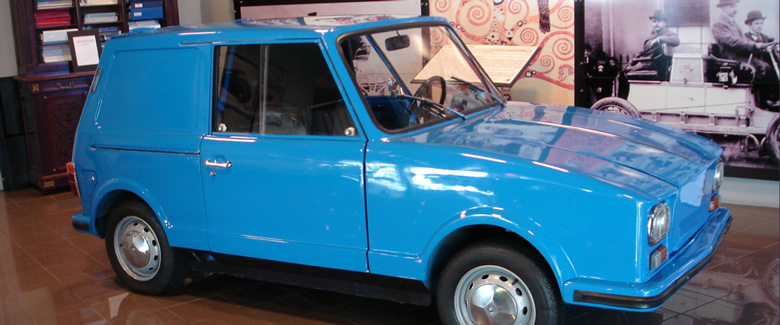
Gregoire himself would be proud that Cerf is using his battery operated city car to test his own theories on fuel cell powered cars.
The other major project of note is that of the Gregoire electric truck. Mr. Cerf is a believer in the future of the fuel cell and has tried without luck to obtain examples of cars built by Honda to meet California emissions goals. He has not been able to obtain a California car nor any other fuel cell powered car. It seems that the technology is considered too secret and too proprietary to be turned over to a mere mortal.
Hence, the purchase of the Gregoire, a small battery-powered vehicle used in the city of Paris in the 1970s. Alain Nerf intends to use this as the mule to test is own theories about fuel-cell powered cars.
Mr. Cerf has obviously the intellectual capacity, the curiosity and the wherewithal to do some very serious investigations into what might be the best answer for our clean air transportation quandaries.
I would recommend that everyone go to the museum’s web site. Better, if you ever come to southwest Florida, pay a visit. If you get lucky you will receive a tour led with knowledge and enthusiasm by a man who casts a loving eye on his automotive past yet is a visionary with some big ideas for the future.
PS The Museum is not just about French cars, but technically interesting cars from a variety of countries. Cerf also has an Adler Trumpf…which as Michel Van Peel pointed out in our recent article on the Bastille French Car Day, might just trumpf the TA as the first mass produced front wheel drive car. Readers?


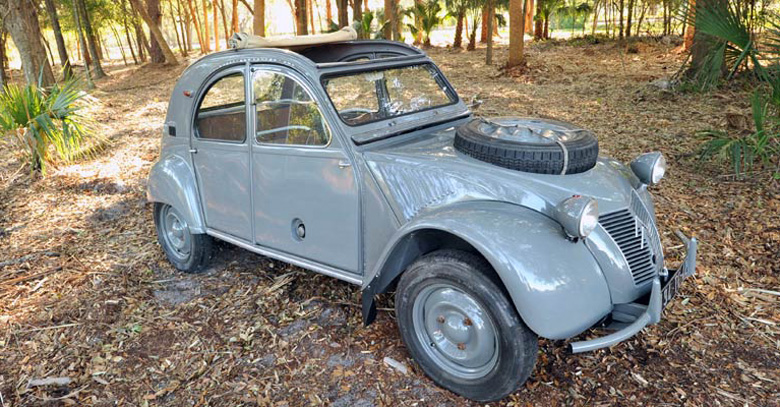
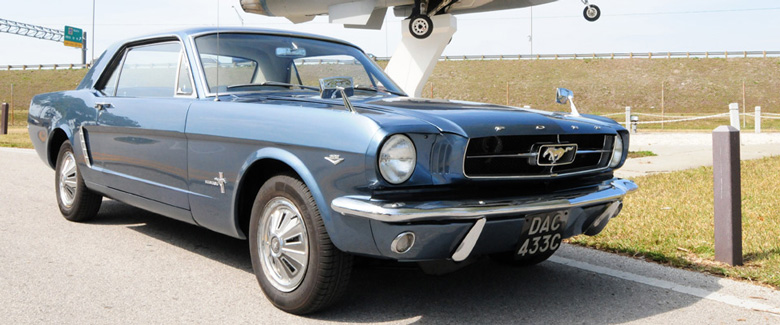
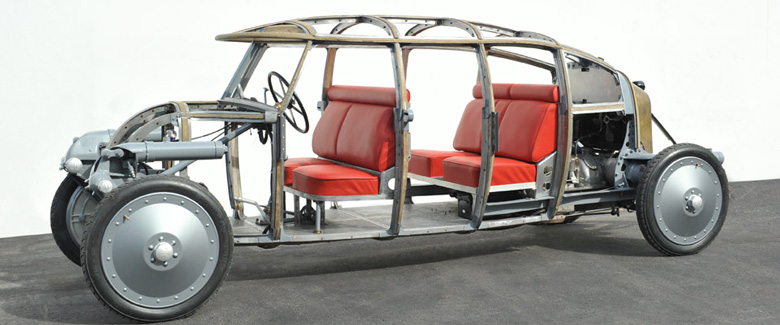
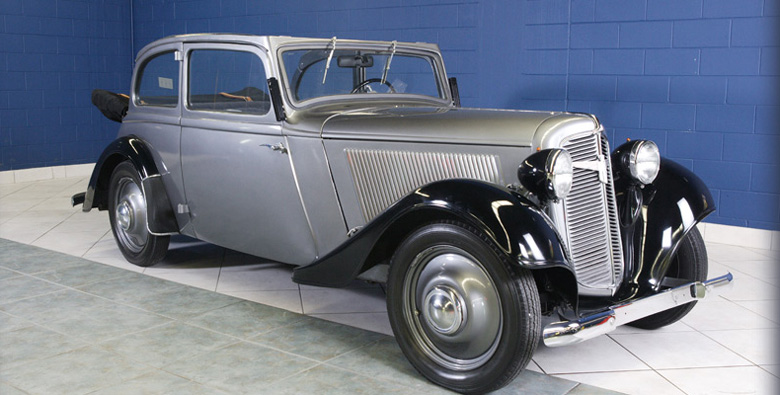
I’ve been twice and as an engineer, I rate it as the best car museum I’ve ever been to. So many innovative creations.